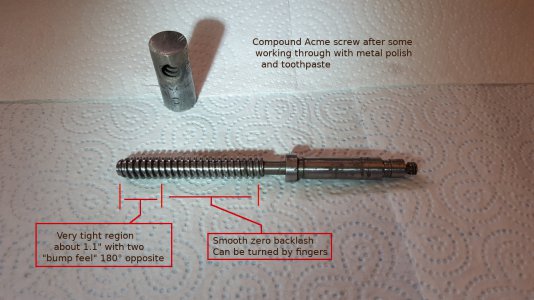OK - we make a discovery.
Much of the reason it can be so difficult to get the screw to run up the nut again, and why the force was enough to crack the mold away from metal adhesion on one side when first extracted, is because the mold was cast on a worn part of the screw - somewhere in between the V-blocks as it was set up. This wear is not on the crests of the screw. That measure was 0.372" all the way along. The wear is on the
sloping parts of the thread.
As I "lapped" the screw into the nut, using only metal polish and toothpaste, everything slowly becomes easier. This form of lapping is ultra slow, and relatively harmless. We start to discover that in the first inch or so, something feels "out of round", in that there are two "easier spots" 180° opposite each other. "Easier" is a relative term. It's damn tight most of the rotation. There was some feature cast, affected by the fact it was set in a U-shape, and in a part of the screw that had seen more use. I have marked up the earlier picture to show this.

If I leave it in it's current state, then I will have a repair part that should work just fine over the region of compound position most used, but it will encounter the stiffer unworn part when screwed to near it's extreme. Had I cast the nut on the unworn thread in the first inch, I might have ended up with a nut that was somewhat looser and "more sloppy" as it found the middle part of the screw.
What I should have done when checking out the screw was to wind some copper wire into the threads, and measured across, or used "thread pins", but I don't have a set of those.
The backlash is nothing! It cannot be felt, not even "rocking". Now I know that the screw is "unique", should I come to re-make it as part of a larger dials upgrade, then it will have to have it's own new nut to match. The experiment nut only has to survive taking some 3mm off the top, to not rub on the casting, and it can become a "repair part" for the present, because it will be a huge improvement on what was there before, even if looking a bit "experimental".
Actually - it kind of has to do service now, because I sacrificed the original working nut in a manner.. well.. kinda permanent!



